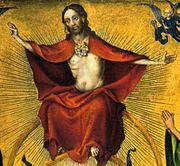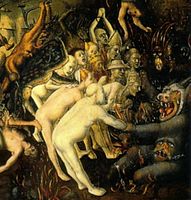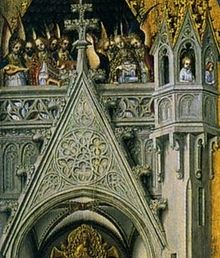
The Last Judgment, Final Judgment, Day of Reckoning, Day of Judgment, Judgment Day, Doomsday, Day of Resurrection or The Day of the Lord is a concept found across the Abrahamic religions and the Frashokereti of Zoroastrianism.

A "Doom painting" or "Doom" is a traditional English term for a wall-painting of the Last Judgement in a medieval church. This is the moment in Christian eschatology when Christ judges souls to send them to either Heaven or Hell.

Stefan Lochner was a German painter working in the late International Gothic period. His paintings combine that era's tendency toward long flowing lines and brilliant colours with the realism, virtuoso surface textures and innovative iconography of the early Northern Renaissance. Based in Cologne, a commercial and artistic hub of northern Europe, Lochner was one of the most important German painters before Albrecht Dürer. Extant works include single-panel oil paintings, devotional polyptychs and illuminated manuscripts, which often feature fanciful and blue-winged angels. Today some thirty-seven individual panels are attributed to him with confidence.

The Last Judgment is a triptych attributed to Flemish painter Hans Memling and was painted between 1467 and 1471. It is now in the National Museum in Gdańsk in Poland. It was commissioned by Angelo Tani, an agent of the Medici at Bruges, but was captured at sea by Paul Beneke, a privateer from Danzig. A lengthy lawsuit against the Hanseatic League demanded its return to Italy. It was placed in the Basilica of the Assumption but in the 20th century it was moved to its present location.

Christ in Majesty or Christ in Glory is the Western Christian image of Christ seated on a throne as ruler of the world, always seen frontally in the centre of the composition, and often flanked by other sacred figures, whose membership changes over time and according to the context. The image develops from Early Christian art, as a depiction of the Heavenly throne as described in 1 Enoch, Daniel 7, and The Apocalypse of John. In the Byzantine world, the image developed slightly differently into the half-length Christ Pantocrator, "Christ, Ruler of All", a usually unaccompanied figure, and the Deesis, where a full-length enthroned Christ is entreated by Mary and St. John the Baptist, and often other figures. In the West, the evolving composition remains very consistent within each period until the Renaissance, and then remains important until the end of the Baroque, in which the image is ordinarily transported to the sky.
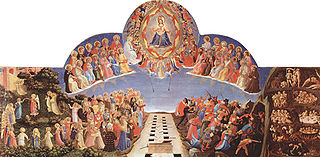
The Last Judgment is a painting by the Renaissance artist Fra Angelico. It was commissioned by the Camaldolese Order for the newly elected abbot, the humanist scholar Ambrogio Traversari. It is variously dated to c1425, 1425–1430 and 1431. It was originally sited in the church of Santa Maria degli Angeli and now is in the museum of San Marco, Florence. It is not to be confused with another Fra Angelico Last Judgement in the Gemäldegalerie, Berlin.
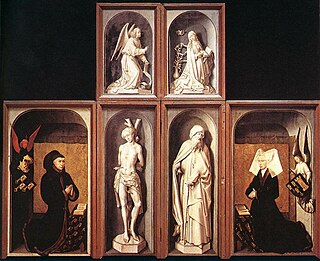
The Beaune Altarpiece is a large polyptych c. 1443–1451 altarpiece by the Early Netherlandish artist Rogier van der Weyden, painted in oil on oak panels with parts later transferred to canvas. It consists of fifteen paintings on nine panels, of which six are painted on both sides. Unusually for the period, it retains some of its original frames.

The Last Judgment is a triptych by the Early Netherlandish artist Hieronymus Bosch, created after 1482.

The Master of the Heisterbach Altarpiece was a German painter active around Cologne between 1440 and 1460.

The Crucifixion and Last Judgement diptych consists of two small painted panels attributed to the Early Netherlandish artist Jan van Eyck, with areas finished by unidentified followers or members of his workshop. This diptych is one of the early Northern Renaissance oil-on-panel masterpieces, renowned for its unusually complex and highly detailed iconography, and for the technical skill evident in its completion. It was executed in a miniature format; the panels are just 56.5 cm (22.2 in) high by 19.7 cm (7.8 in) wide. The diptych was probably commissioned for private devotion.

Madonna of the Rose Bower is a panel painting by the German artist Stefan Lochner, usually dated c. 1440–1442, although some art historians believe it contemporaneous with his later Dombild Altarpiece. It is usually seen as one of his finest and most closely detailed works.

The Saint Columba Altarpiece is a large c. 1450–1455 oil-on-oak wood panel altarpiece by Early Netherlandish painter Rogier van der Weyden painted during his late period. It was commissioned for the church of St. Columba in Cologne, and is now in the Alte Pinakothek, Munich. It depict scenes from the early life of Jesus. They show, from left to right, the Annunciation, the Adoration of the Magi and the Presentation, when she presents the infant at the Temple in Jerusalem. In each panel, Mary is distinguished by her blue clothes. The reverse of the exterior panels are covered with plain paint and lack indication that they ever contained donor portraits as were typical for the time.

Presentation of Christ in the Temple is a painting by the German artist Stefan Lochner, created c. 1447. it is held in the Calouste Gulbenkian Foundation, in Lisbon. It was once the wing of a diptych, the opposite, now separated, panel was a depiction of the Nativity. Its reverse shows the Stigmatisation of St. Francis. The panel is dedicated to St. Catherine and shows the purification of the Virgin. It is the first of two of Lochner's treatments of the subject - a larger painting completed two years later is kept at the Hessisches Landesmuseum, Darmstadt, Germany. The two panels are the only known dated paintings left by Lochner.
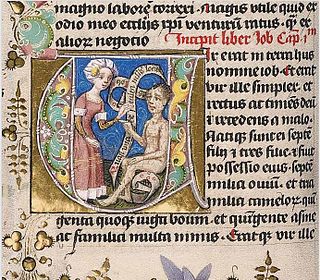
The Prayer book of Stefan Lochner is an illuminated manuscript attributed to the German artist Stefan Lochner. Dated to the early 1450s, the Book of hours consists of 235 leaves, each folio measuring 108 x 80mm. The extent of Lochner's involvement is debated; workshop members were probably heavily engaged in its production. However, his style, or at least that of his followers, can be detected in the overall layout; the colourisation, vivid and harmonious flowers in the borders, and the delicate treatment of the foliage are all characteristic of his style.

Annunciation is a panel painting by the German artist Stefan Lochner, from c. 1446-1449. The panels were probably conceived as an outer wing for a lost altarpiece. It shows the virgin, rather conventionally receiving the voice of the Holy Spirit, who hovers above her in the form of a dove. A vase behind her holds a lily. Her white clothes and the flower represent her virginity. It seems influenced by similar panels found in Jan van Eyck's Ghent Altarpiece.

The Adoration of the Magi Altarpiece is a painted triptych by the German artist Stefan Lochner, created c. 1440–1442. Originally painted for the council-chapel St. Maria in Jerusalem in Cologne, it was moved to Cologne Cathedral in 1810 and is now in that church's Marienkapelle, south of the choir. It is also known as the Three Kings Altarpiece (Dreikönigsaltar) and the Patron Saints of Cologne Altarpiece.

The Mosaic ceiling of the Florence Baptistery is a set of mosaics covering the internal dome and apses of the Baptistery of Florence. It is one of the most important cycles of medieval Italian mosaics, created between 1225 and around 1330 using designs by major Florentine painters such as Cimabue, Coppo di Marcovaldo, Meliore and the Master of the Magdalen, probably by mosaicists from Venice.

The Last Judgement Triptych is a triptych by Georgios Klontzas. Klontzas was a Greek painter and prominent member of the Cretan School. He is likened to El Greco and Michael Damaskinos. His artistic period was between 1550 and 1608. He had a workshop in Heraklion, Crete. He created many forms of art such as triptychs, portable icons or paintings, and manuscripts. Klontzas created several versions of the Last Judgment or Second Coming. His The Last Judgment also features the same theme but is a painting, not a triptych. Klontzas also created other triptychs.

The Last Judgment also known as the Second Coming is a painting by Leos Moskos. His artistic legacy was during the 17th century. Twenty of his paintings survived. He shared the same last name as Elias Moskos and Ioannis Moskos, they may have been related. All three painters flourished during the same period. Moskos worked all over Europe namely, Crete, Zakynthos, and Venice. His student was famous painter Nikolaos Doxaras.

Triptych of the Last Judgement is a tempera-painted triptych created by Cretan Renaissance painter Georgios Klontzas. Klontzas was active in Crete during the later part of the 16th century. El Greco was active around the same period and was also from Crete. Klontzas was hired to assess his work. Klontzas completed tempera paintings, triptychs, and illuminated manuscripts. His existing catalog comprises over fifty-four pieces of his art. Klontzas frequently painted the theme of the Last Judgment. Some of his well-known works include The Last Judgement Triptych (Klontzas) and The Last Judgment (Klontzas). The Vatican owns Triptych of the Just in Glory also created by Klontzas which also features the Last Judgment.





